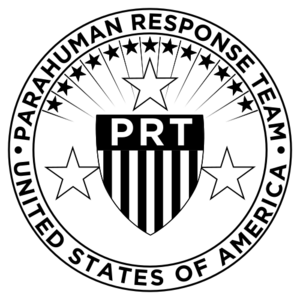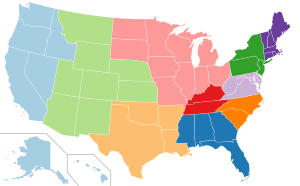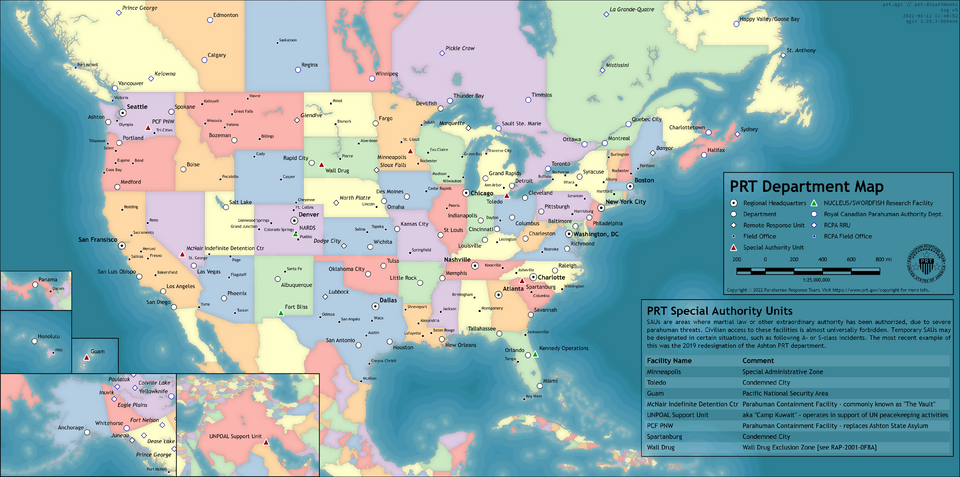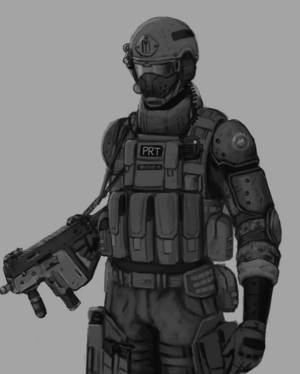Devilfish:Parahuman Response Team
Looking to play the PRT? At the current time, we only allow members with the @PRT tag on the discord to help out as the PRT. If you are interested in this, please contact the Lore Mods and request an application. |
1985, The year that changed the world.
It wasn't long after the appearance of Wild Hunt that powers began to appear. With the powers came a still-not-understood drive to fight. Heroes and villains alike became less the figments of comic books and shitty cartoons, and more a very real, very present danger.
On March 15, 1985, President Ronald Reagan ordered the creation of the Presidential Parahuman Advisory Committee, with the mission and goal of developing an understanding of the parahuman phenomena. Formed from key officials of the DoD, HHS, DoJ, and State Department, the PPAC was at first regarded as a glorified science experiment, looking for a reason why powers were occurring.
And then the calls started. A national exposé on parahuman crime had aired in primetime, casting a rather negative view on the fledgling society of capes. With the public scared and angry at the potential power the parahumans held, the PPAC was urged to form a unit specializing in tactics to counter capes. This was the birth of the Parahuman Response Team.
Originally a small group flying across the country and educating local SWAT teams, the PRT soon evolved into its own distinct unit under the Department of Justice. Their goal changed as well over the next several years; the early days of "kicking the freaks' skulls in" had turned to "cooperation and oversight of heroes... and kicking the villains' skulls in". Baby steps. By the time the 90s rolled around, the PRT had fully adopted the cape culture as we know it today.
Organization of the PRT
The PRT is headed in Washington, DC, under the rulership of the Chief Director of the PRT, a political appointment that must be confirmed by the senate. As such, most of the day-to-day operations are handled by the Chief Director's direct subordinates, who are each in charge of a different region of the US.
There are PRT departments in every state, ranging from regional headquarters like those in New York, Los Angeles, Denver, Chicago, and Atlanta (among others), to tiny satellite offices in small towns all across America. In each of these cities, the PRT has direct oversight over the local hero teams. In most cases, these are the government-sponsored teams (the Protectorate, and its junior branch, the Wards), however in some cases private and corporate teams may be formally permitted by the PRT in exchange for funding.
Smaller local offices will work alongside local police and emergency services, providing them guidance and support to work with capes, while larger departments will usually staff their own troops. These PRT officers act as a cross between conventional police and military forces, although with a strong bias towards nonlethality.
Day to Day PRT
The duties of the modern PRT are threefold: containing villains, promoting heroes, and finally, overseeing the government-sponsored teams. Each of these duties are headed by a separate organizational unit, some of which are detailed below.
- The Administration segment oversees the entire operations of the three other segments, as well as guidance to the department as a whole.
- The Protectorate segment is comprised entirely of capes and their support staff, and is responsible for all their actions both with day-to-day minutia and long-term strategy for the team. The Wards are a subordinate team to the Protectorate, and use most of the same staff and equipment.
- The Operations segment handles the entire non-parahuman side of PRT law enforcement. PRT officers perform regular patrols, defend key points in the city, and transport prisoners and VIPs as needed. They also collaborate with the Protectorate regularly as needed.
- Finally, the Image department is responsible for publicity for all heroes in the city. Alongside government funding, income from the Image department is responsible for the vast majority of PRT revenue. Thus, their opinion is given heavy weight in all considerations.
Publicity
The Image department's handling of publicity is one of the most important aspects of the PRT. By their very nature, capes are purpose-built to fight and kill, and it is Image's job to convince the public otherwise. To this extent, they have their fingers in a lot of pies:
- The PRT owns and operates outlets in all of their departments, as well as in malls and commercial areas. These outlets sell cape merchandise of all kinds, hero and villain. Profits are distributed to the PRT, PRT teams, and even registered hero teams in the area.
- The issue of villain merchandise can be controversial, however in 1998 this was settled by the Supreme Court in Doe v. PRT, which held that profits from villain merchandise would not be given to the villains in question (other than a portion set aside for them as a prison commissary account). Note that the PRT does not sell merchandise from particularly infamous villains, in these cases the consumer must try another merchant.
- Image will also handle outfitting of costumes for capes. For the independent heroes willing to work with the PRT, this can be a cheap and practical alternative to commissioning one's own work.
- They also handle media arrangements and other, more conventional publicity work for heroes and the PRT.
- Finally, the PRT retains a 20% stake in Parahumans Online, which it founded in 1993. Currently the PRT has no role in the operations of PHO, although the more tinfoil-loving critics will claim otherwise.
Containment Foam
Confoam is the most valuable tool in the PRT's arsenal, however, it is also one of the rarest-used. Manufactured at an undisclosed location somewhere in the Midwest, confoam is a liquid that, when sprayed through a specialized launcher, will quickly form an incredibly-hard (and impossible to escape from) foaming glue.
While all PRT squads train to use confoam (the launcher is large and bulky, requiring two people to operate), it is seldom used due to both cost and liability reasons. It is only deployable on order of the Director or Operations Deputy Director, an action that will only occur for the most wanted of criminals. Even maintaining the equipment costs an alarming amount, so its use is seldom.
Operations
PRT squads are comprised of ten officers, usually operating either as a whole or in two fireteams of five officers each. They will typically operate on either independent patrols throughout the city, or more often will "shadow" a Protectorate or Ward patrol. In the event of a parahuman fight breaking out, PRT officers will typically intervene only to protect civilian life, and will leave actual apprehension of the villains involved to those with powers. This means that most often during a fight, their role is to get civilians out of harms way and as far away from the danger as possible.
Standardized PRT Loadout
- Note: may vary based on local departmental resources and requirements.
Each troop is equipped with standard ALKE Mk VIa PRT armor, which is bulletproof (IIIa) and stab resistant. Although not airtight, the uniform doesn't expose any skin. It's composed primarily of kevlar and nomex with a chain mail underlayer.
- Service pistol (Beretta M9)
- Shock baton
- PRT comms (p25 with NUCLEUS encryption modules)
- CBR gear (Gas mask etc)
- OC Spray
- Zip Tie handcuffs
- Flashlight
Contained in the vehicles is the following “spare” gear to be used as needed:
- 6x Rifle (M16A4)
- 2x Shotgun (Mossberg M590)
- Ammo for days
- 2x Confoam launchers (foam canisters kept at PRT typically)
- Positive pressure suits with SCBA gear
- Flame-retardant gear
- 2x Brute/Striker-rated handcuffs
- 10x Beanbag shotgun rounds
- Pepperball Rounds
Kept at the base to be used in certain situations:
- EMP grenades (NUCLEUS tech)
- Confoam canisters (NUCLEUS tech - Director/Dep Dir Ops release only)
- Anti-materiel rifles (Barrett XM500)
- HEAP ammo (High Explosive- Armor Piercing)
Standard PRT Vehicles:
- 1x "Minivan" personnel transport - Seats six with plenty of room for gear. Optional turret ( controlled from console behind driver's seat.
- 1x "Paddywagon" containment truck - Can fit five troops in the front cab, but it's cramped. Can hold up to four parahumans in the back, in divided cages. Typically a couple of the troops will chill back there unless they can't for whatever reason.
ALKE Light combat armor (Mk VIa)
The ALKE light combat armor platform is the mainstay of PRT forces, providing excellent protection and flexibility without sacrificing significant mobility. The most recent iteration consists of a breathable undersuit with integrated cooling loops, a layer of chain mail, and an outer shell consisting of a combination of nomex and kevlar composites. A helmet with integrated comms systems can also fit SCBA gear in case of airborne threats (note that while the armor leaves no exposed skin other than the face, it is not considered airtight).
The system provides NIJ 0101.06 level IIIa armor protection and comprehensive stab protection, enabling enhanced resistance to a broad spectrum of physical parahuman threats when properly utilized.
The first iteration of ALKE combat armor was introduced in 1992, before which PRT Operations squads used off-the-shelf armor similar to that used by SWAT teams.
KERES Heavy combat armor (Mk Ib)
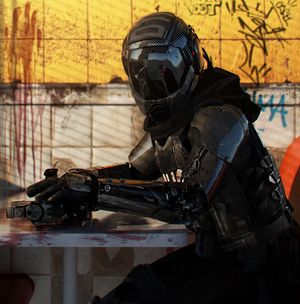
First introduced in 2015 as a response to increased officer casualties from Brute-related threats, the KERES armor represents a significant upgrade to standard ALKE combat armor. A modified ALKE undersuit is worn as the base layer, with monitoring systems weaved into the fabric. On top of this, a titanium exoskeleton is worn, over which composite steel/kevlar armor is integrated. The helmet completely encloses the head, and in addition to standard commlink provides a HUD overlay providing health feedback, environmental data, and other essential combat data.
It rates level IV NIJ bulletproofing, full CBRN protection, augmented burst lift strength of 250lbs, and approximately two hours of use before a recharge is required. Due to these requirements, and its significant purchase, upkeep, and training expense, the armor is only deployed to facilities where an enhanced Brute threat response is required.
A Mark II iteration has been in the works at the NUCLEUS Fort Bliss facility, however while a few modified prototypes exist it’s considered not quite ready for production.
PROIOXIS Special response framework
Less a conventional armor system than the other options, the PROIOXIS framework was developed in collaboration with the NUCLEUS Fast Armor Repair Team to develop a power armor “skeleton” that could serve as a base for Protectorate Tinker power armor designs. Essentially, a conventionally-produced platform that can be easily repaired or replaced by PRT technicians, allowing the Tinkers to concentrate on other aspects of the armor design.
The framework enables production of power armor weighing up to 4,000 lbs, with an integrated CAN bus data system, power network, and control API. While regenerative power systems can be fit, a source of power such as battery or generator must be provided by the Tinker, either their own design or one provided by the NUCLEUS favor network.
